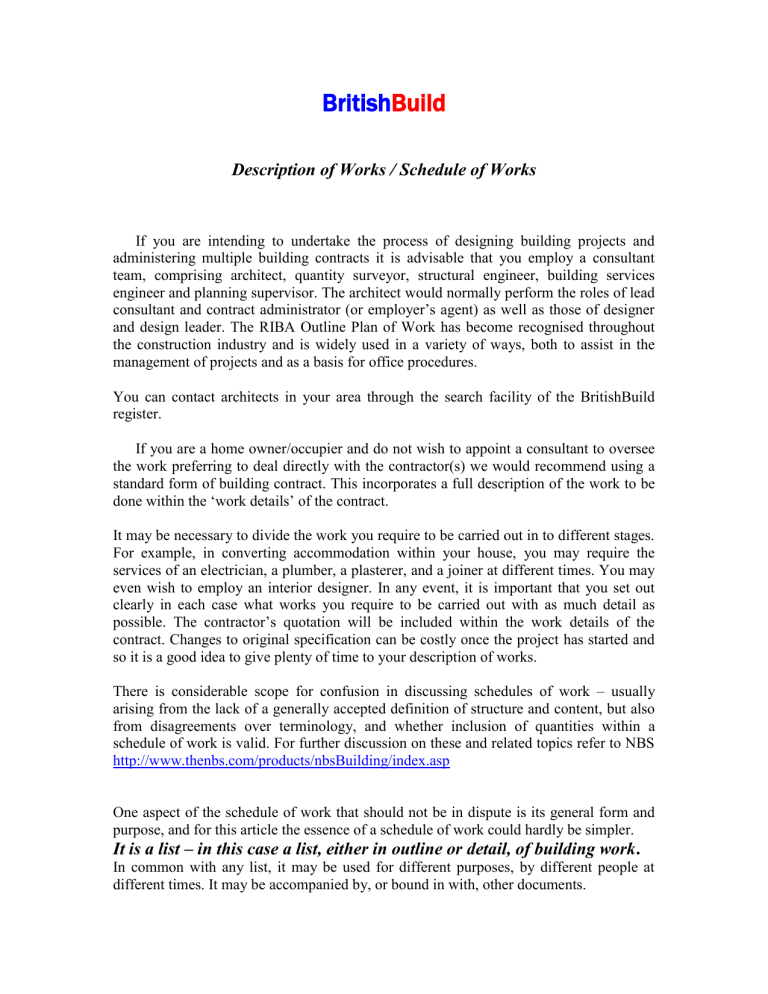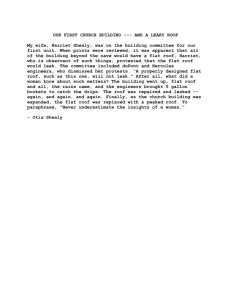Description of Works / Schedule of Works

British Build
Description of Works / Schedule of Works
If you are intending to undertake the process of designing building projects and administering multiple building contracts it is advisable that you employ a consultant team, comprising architect, quantity surveyor, structural engineer, building services engineer and planning supervisor. The architect would normally perform the roles of lead consultant and contract administrator (or employer’s agent) as well as those of designer and design leader. The RIBA Outline Plan of Work has become recognised throughout the construction industry and is widely used in a variety of ways, both to assist in the management of projects and as a basis for office procedures.
You can contact architects in your area through the search facility of the BritishBuild register.
If you are a home owner/occupier and do not wish to appoint a consultant to oversee the work preferring to deal directly with the contractor(s) we would recommend using a standard form of building contract. This incorporates a full description of the work to be done within the ‘work details’ of the contract.
It may be necessary to divide the work you require to be carried out in to different stages.
For example, in converting accommodation within your house, you may require the services of an electrician, a plumber, a plasterer, and a joiner at different times. You may even wish to employ an interior designer. In any event, it is important that you set out clearly in each case what works you require to be carried out with as much detail as possible. The contractor’s quotation will be included within the work details of the contract. Changes to original specification can be costly once the project has started and so it is a good idea to give plenty of time to your description of works.
There is considerable scope for confusion in discussing schedules of work – usually arising from the lack of a generally accepted definition of structure and content, but also from disagreements over terminology, and whether inclusion of quantities within a schedule of work is valid. For further discussion on these and related topics refer to NBS http://www.thenbs.com/products/nbsBuilding/index.asp
One aspect of the schedule of work that should not be in dispute is its general form and purpose, and for this article the essence of a schedule of work could hardly be simpler.
It is a list – in this case a list, either in outline or detail, of building work.
In common with any list, it may be used for different purposes, by different people at different times. It may be accompanied by, or bound in with, other documents.
Supporting documents
Even simple building work can require a lot of description and the schedule of work is usually accompanied by other documents providing information supplementing the listed items, including:
Drawings – to illustrate extent of the work;
Schedules – itemized lists of particular product types, commonly doors, windows, ironmongery, finishes and decorations;
Specification – to describe the standards to which each category of work is to be carried out;
Preliminaries – to determine general requirements for the project as a whole, usually with reference to a particular standard form of building contract.
Differing uses throughout project
A simple list can serve a number of uses, and the schedule of work is no different.
Together with the supporting documents, it may be used in the following ways:
Tender document.
Contract document.
Task list for work on site.
Check list for administration.
Record document.
Tender document
The purpose of the schedule of work at tendering stage is to provide sufficient description of the proposals to allow a number of independent building contractors (usually a minimum of three) to calculate fair and, hopefully, competitive prices for the work. In general this task will be undertaken by quantity surveyors (who may be employed directly by the contractor, and are then generally referred to as ‘estimators’). They will price all listed items, to determine an overall cost.
The descriptions in the schedule of work must be unambiguous. They need not be complete in themselves, but may cross refer to the accompanying documents – particularly to the drawings. However, they must cover, at least in outline, all aspects of the work for which prices are required. Taken together the information provided must allow the contractor to identify all the materials needed and to calculate the quantities that will be required.
Contract document
Once a price has been agreed the schedule of work will form part of the legally binding
‘contract documents’ between employer (the building owner) and contractor.
Task list
The schedule of work, exactly as issued for tendering purposes, is also used on site by the contractor’s workforce on a day to day basis to determine work required during construction. For use on site, the schedule of work and accompanying documents must not only identify the materials and allow calculation of quantities involved, but also give precise instructions on where all the materials are to be used and how they are to be fixed together. It should also set out an ordered arrangement of tasks to be carried out, in the correct sequence to achieve the desired end result.
Check list
The contract administrator (CA – who may be an architect, an architectural technologist, a building surveyor or other construction professional) is not necessarily the individual who wrote the schedule of work or produced the drawings. The CA will use the schedule of work to check that each of the listed items is being – or has been – carried out. The CA may also use the prices against checked items in the schedule of work to periodically calculate the value of the completed work.
Record document
The original schedule of work and supporting documents, together with descriptions of variations from the work originally intended, may be archived as an ‘as built’ document set for record purposes. In certain instances, if serious faults are later found, the schedule of work, as part of this document set, will again be studied in detail.
In general it is likely that the schedule of work must be read, and understood, by perhaps four or more sets of people who must each be able to use the document (and its supporting documents) to gain a particular understanding of the building. The extent to which these aims may be met depends largely on the structure of the schedule of work itself. There must be a methodology behind the description that relates closely to the type and extent of the work being carried out.
The schedule of work is rarely, if ever, used in isolation. It is commonly bound together with contract preliminaries (describing general project requirements and contract terms) and with a specification document describing minimum acceptable product and workmanship standards. This group of documents may then be supported by drawings and itemized lists (also, confusingly, known as schedules), bundled separately or bound in as appendices.
The schedule of work is the core of this document set and, particularly where its descriptions are in outline, it must cross refer to the supporting documents. Inevitably it may become relatively complex. This complexity must be controlled, and this can best be done by careful selection of an appropriate structure for the schedule of work.
The types of building work for which schedules of work are used vary widely but there are, typically, two extremes – new work and maintenance/ refurbishment work – which are best met by wholly different formats of description.
In all cases the schedule of work need not be fully descriptive if work is covered in detail on drawings etc. The only essential is that the schedule of work provides a pricing point for all work – the complete description may lie elsewhere.
New work
Imagine a very simple new brick walled two storey house with a tiled pitched roof. There is really only one way in which this can be built – from the bottom up. First, existing buildings or vegetation on the site must be cleared to allow work to take place at all. Then foundation trenches must be dug and foundations laid, followed by the lowest course of the walls and then the ground floor slabs. Walls are then built up to support upper floors and roofs. Services are installed and the whole building plastered out and decorated.
Finally the site is tidied up, fences and garden walls constructed and planting carried out.
A logical format for the schedule of (new) work is to mirror this activity, so the schedule of work will be arranged under ‘elemental’ headings such as ‘site clearance’, then
‘foundations’, ‘walls below damp proof course’, ‘ground floor slabs’ continuing through to 'upper floor structure', 'roof structure', 'roof covering' and completed by ‘plumbing’,
‘electrical work’, ‘decorations’ and, finally, by ‘external works’, all laid out in construction sequence.
Such a format is a helpful progression not only for the specifier trying to ensure that everything is covered, but also for the tenderer putting costs to the work and for the operatives on site putting the building together. For a very small building there may be little need to divide each element into smaller parts. For a larger building the main headings would be much the same, but each might then be subdivided. Rather than 'roof covering' there might be separate headings or descriptions for 'porch roof covering', 'main roof covering' and 'dormer roof covering' – each to be priced (and, obviously, constructed) separately.
The extent of this division should also take account of any need for valuing the work during construction. It is the expectation of most forms of contract for small works that valuations will be carried out (and payments made to the contractor) on a monthly basis.
In general the method of valuation by the contract administrator will be to determine, as closely as reasonably possible, the percentage complete of each piece of work priced in the tender – so a tiled roof on which 50% of the tiling has been completed will be valued to give a maximum of half the contractor's tender price for the roof tiling. This task will be made much simpler and more transparent if each priceable item is relatively simple – this may require separate priceable items for, e.g. 'purlins', 'rafters', 'insulation between rafters', 'roof underlay and counterbattens', and 'tiling battens and roof tiling'.
Refurbishment work
Refurbishment/ maintenance work is very different in that all parts of the building already exist and there may be no compelling reason, as far as the specifier is concerned, to describe one particular type of work before another.
Maintenance work commonly involves repair or replacement of doors, windows, fences, rainwater goods etc. Given that contractors pricing the work and operatives carrying it out will tend to deal with all items in a particular location before moving on to the next, this is also the pattern commonly used for a ‘locational’ structure to a schedule of
(refurbishment/ maintenance) work.
Actual headings will depend on how well defined is the use for each area of the building.
A house or apartment refurbishment is likely to use headings such as ‘porch’, ‘hall’,
‘lounge’ and ‘kitchen’, whilst an office building might be better served simply by ‘room
1’, ‘room 2’ etc. In general each element within each room will be described and priced separately, making valuation by the contract administrator during the course of the work relatively straightforward.
Other structures
There are, of course, many possible variations within these extremes. Alteration work commonly involves refurbishment/ maintenance together with elements of new work, e.g. new partitions, that may not best be described as belonging to a particular room. In such a case the structure for the schedule of work may require to be split to identify new work separately from refurbishment/ maintenance.
The key always is to identify and outline the most appropriate structure for a schedule of work before starting the description of the work itself.
Visit http://www.thenbs.com/





